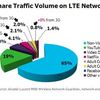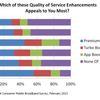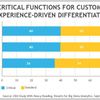In this third installment of the Six Degrees of Mobile Data Plan Innovation blog series, Alcatel-Lucent’s Rich Crowe explores the concept of shared data plans. Shared plans allow several users or devices to connect to and share a common pool of mobile data. Operators can use shared plans to encourage subscribers to buy more data and connect more devices and users to the mobile network.
Mobile data: It’s nice to share
From an early age, we’re taught that it’s nice to share. With time, we learn the value of sharing things like cookies, good books and the wisdom that comes from experience. But what about sharing mobile data? Do consumers want to share their mobile data? What would this look like?
Consumers continue to buy devices that can be connected to the mobile network – phones, tablets, laptops, game systems, and even connected cars. The ITU projects that 25% of mobile consumers will own more than one mobile device by 2016. But consumers aren’t connecting all of these devices to the cellular network because it’s expensive and inconvenient to maintain multiple mobile data plans. The buying trends are telling: According to Infonetics, 68% of all tablets shipped in 2012 were Wi-Fi® only. [1]
Most consumers agree that it would be nice to have the ability to share data across several devices. Studies by Strategy Analytics indicate that 60% of smartphone owners want a single shared data plan that can connect multiple devices.
Mobile network operators like shared data plans, too. The worldwide mobile market is reaching saturation (Table 1), and it’s getting tougher for operators to attract new subscribers. Operators see shared data as an avenue for growth.
Table 1: Estimated mobile penetration in developed and developing nations
|
|
Global |
Developed nations |
Developing nations |
|
Penetration of mobile cellular subscriptions |
96.20% |
128.20% |
89.40% |
|
Penetration of active mobile broadband subscriptions |
29.50% |
74.80% |
19.80% |
|
Source: International Telecommunication Union (February 2013) via mobiThinking |
|||
What is a shared data plan?
With shared data plans, subscribers can connect several devices and subscribers to a single pool of data. They pay a monthly fee based on the size of this pool, and an additional monthly fee for each device they connect to the plan. This connection fee is lower than the cost of buying a separate data plan for each device. In most cases, subscribers also enjoy significant (or even unlimited) voice and messaging as part of their shared plans. To offer these shared plans to subscribers, operators need support from an online charging system and a subscriber data manager.
Businesses can use shared plans to cost effectively manage mobile data across departments and devices. To offer shared data plans to businesses, operators need an online charging system that can allocate usage to hierarchies of groups and departments and aggregate usage into higher-level quotas. These capabilities will allow operators to connect even more people and devices to large pools of data to serve businesses of all sizes.
How subscribers benefit from shared data plans
|
Shared data plans have room to grow Multi-device shared data plans are available to only 5% of worldwide mobile subscribers. Source: ABI Research via FierceWireless |
For subscribers, shared data plans are about convenience and cost savings. Simpler billing and account management top the list of subscriber benefits. Shared plan subscribers have only one account to manage for all devices connected to the plan. Subscribers can focus solely on data, since voice and messaging are part of the plan. Connecting a new device to an existing plan is as easy as adding an additional monthly line charge.
Shared plans can help subscribers and businesses extract more value from data. For example, many subscribers don’t consume their full monthly data allowance. By adding a new device to an existing shared data plan, subscribers can use data that would otherwise be wasted. This can be more cost effective than buying a separate data plan for each device. Comparison shopping will help subscribers determine when shared plans provide the best value.
How operators benefit from shared data plans
Shared data plans help operators expand the market and extend their focus beyond the fight for market share. These plans encourage new and existing subscribers to connect more devices and to upgrade to devices —smartphones, 3G or LTE enabled tablets — that can take advantage of cellular data. A shared data plan may also encourage parents to connect additional cellular data-enabled devices for their children. As subscribers add more devices and people to their plans, they become “sticky.” It’s harder to change service providers when so much is attached to the same plan.
Shared plans offer operators several viable paths toward a better bottom line. For example:
- Usage will increase as more devices and subscribers are connected to the same data plan. This will inspire subscribers to purchase larger data plans.
- The decline of voice and messaging revenues will stop if shared plans include voice and messaging services. Subscribers will also be more likely to use the operator for these services since “free” over-the-top (OTT) voice and messaging services consume the subscriber’s data allotment.
- The OPEX required to manage and support mobile data subscribers will shrink as more devices are attached to each billing relationship.
Finally, shared plans can also boost an operator’s brand. Simplified billing and account management will increase customer satisfaction. Keeping the subscriber on their network for voice and messaging will help operators prevent the brand erosion that occurs when subscribers use OTT alternatives.
Partnering for shared data plan success
Data may yield additional value when it is shared across the boundaries between families and businesses. Consider what a business could do if it purchased a large pool of mobile data and then, working with the operator, shared its data to reward loyal or high-value consumers.
|
Figure 1: Using shared data to reward loyal consumers |
In this scenario, the business determines how much data to share with consumers, who can access it, and how long the reward is valid. The operator manages consumers’ data usage, charging against the reward or the consumer’s own data pool according to the agreement in place. For example, the operator may charge data usage against the reward until it is consumed and then revert to the consumer’s data plan. If consumers lose unused data at the end of the month, the reward could be set up to offset overages once the consumer’s data pool is consumed.
Since the business and operator both contribute to the offer, the operator can use this partnership as an opportunity to attract the business’s loyal customers to its network.
Read the ‘Six Degrees of Mobile Data Plan Innovation’ blog series:
Six Degrees of Mobile Data Plan Innovation: Service Level-based Plans
Bringing customers closer: Six degrees of mobile data plan innovation
Up next in our Six Degrees of Mobile Data Plan Innovation series: application-based plans.
Click here to subscribe to the series, and to get information and updates about the latest in mobile data plan innovation.
[1]“3G and 4G Mobile Broadband Devices and Subscribers Market Size, Share, and Forecasts: 4Q12.” Infonetics Research, March 2013.













